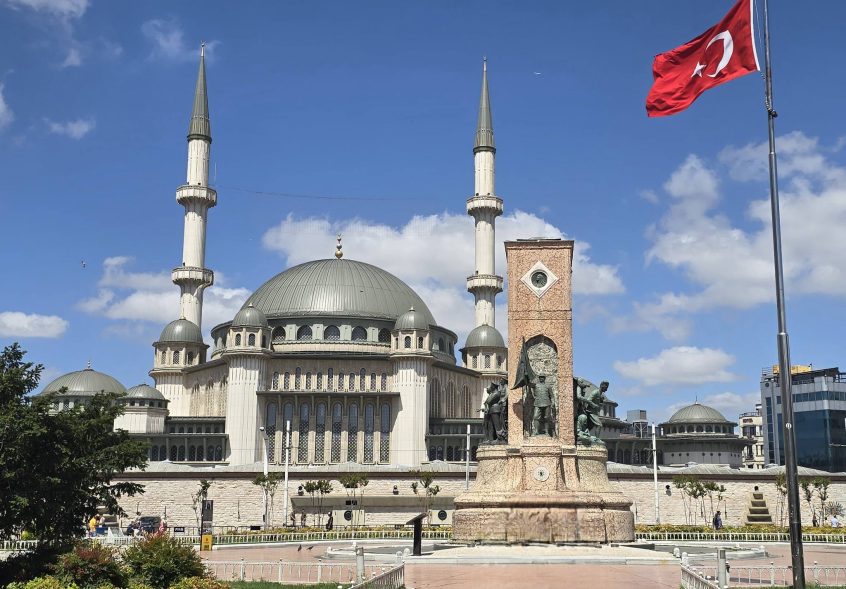I’ve had a food day and a shopping day in Istanbul. Today was a culture day.
My first stop was Taksim Square, a bustling hub of activity and a symbol of modern Türkiye. Located in the heart of Istanbul, it’s known for its lively atmosphere, hotels, shops, and restaurants. In the center of the square is the Republic Monument, commemorating the founding of the Turkish Republic. The square is nearly as large as Tiananmen Square in Beijing and like its counterpart, Taksim is a key location for public events, protests, and celebrations. The Atatürk Cultural Center is close by. It’s a new cultural complex, featuring a state-of-the-art opera house, theaters, exhibition halls, and a library.
After wandering around, soaking in Taksim’s atmosphere, I boarded a tram for the Blue Mosque area. There are two museums there I wanted to explore: the Museum of Turkish and Islamic Arts and the Hagia Sophia History and Experience Museum.
I got a little turned around, but that turned out to be a good thing, the fountain in front of the Hagia Sophia was putting on a show. Cool droplets brought down my temperature and made for a stunning scene.
At the Hagia Sophia History and Experience Museum I anticipated being immersed in the history of the Hagia Sophia. I was, but not in the way I expected. The museum employs technology, including interactive displays and virtual reality. Some of it felt a bit cartoonish for my taste, but it did a respectable job of explaining the historical context, covering the construction, restoration, and transformation over the centuries, from a Byzantine Cathedral to an Ottoman Mosque and finally into a museum. There was also a small, but interesting collection of artifacts and relics discovered during archaeological excavations.
The Museum of Turkish and Islamic Arts, located in the Pasha Palace, directly opposite the Blue Mosque, is a more traditional museum. It displays a vast collection of Islamic calligraphy, carpets, ceramics, and ethnographic displays. What it also has are what felt like a zillion steps and no elevator. Stairs and I are not friends and at one point I almost gave up. But the displays were so interesting I continued.
After the two museums I was exhausted. I returned to the hotel to rest before my evening adventure—seeing a Sikh Dervish experience (more commonly referred to as whirling dervishes) and afterwards, eating a local dinner.
I met up with a small group next to a train car near the main railway station. When our guide Zeynap arrived, she explained that this was a stop on the Orient Express and was the inspiration for Agatha Christie’s novel.
Before the Dervishes, Zeynap took us to the Istanbul equivalent of New York’s Soup Man. A tiny hole-in-the-wall food stall had a long line waiting to get the only item on the menu—a “raw” meatball. It isn’t meat, it’s a spicy vegetarian concoction with the consistency of hamburger meat, wrapped in a lettuce leaf. The “Meatball” man yells at customers who don’t order, pay, or grab their food quickly enough. He puts on quite a show.
Then we made a quick stop to sample Turkish Delight, a sweet confection. Zeynap wanted us to sample the “good kind,” rather than the kind sold at most places. She was correct, the “good kind,” was fabulous. The ordinary version, meh.
Then off to Hodjapasha for the Dervish experience. They are careful to say this is not a performance. “Sema” is a ritual, a spiritual journey for musicians and whirling dervishes. Observers are carried along on their journey.
I only have photos from outside because no photography is permitted. I don’t have words to adequately describe the experience, it was like nothing I’ve ever witnessed. It is spiritual, ritualistic, and hypnotic. Everything from clothing, to movements, to objects used has a specific meaning. The whirling is only a part of the ceremony.
The singers, flutist, drummer, and string player created an atmosphere conducive to emptying the mind and focusing solely on the moment. For me, the music was more compelling than the whirling. The ritual lasted one hour. It went by quickly because though only watching it, I felt as though I was a participant. Like the impact of the best spiritual ceremonies, the essence of it must be experienced. Descriptions alone are poor substitutes.
Then we were whisked away by car to dinner. We ate outside in an area with cool breezes. There were enough kebabs, mezze (the Middle Eastern version of tapas), salads, and bread to feed three times as many people. The food was, like everything I’ve eaten in Istanbul, delicious.

